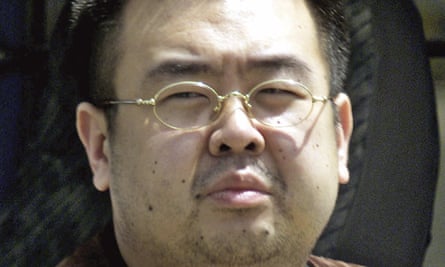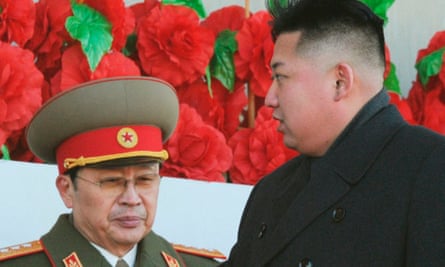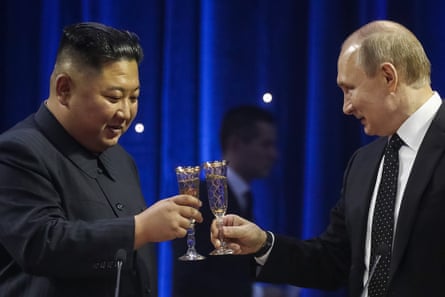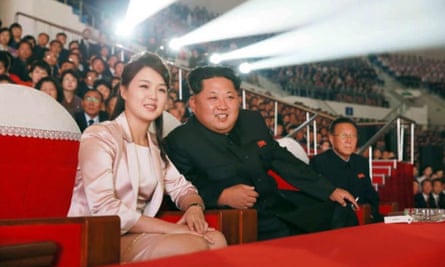It was not, perhaps, the image Kim Jong-un would have wanted to project in his first public appearance as the latest authoritarian leader of North Korea in 2011. As wailing citizens exhibited their grief along the snowbound streets of Pyongyang, Kim, then only in his late 20s, cut a forlorn figure.
Dressed in a long black coat, Kim walked with grim purpose alongside the hearse carrying his father, Kim Jong-il, one hand resting on the bonnet of the 1970s Lincoln Continental, the other executing an awkward salute. He was later seen crying and drying his eyes at the burial service, in footage broadcast on state television.

The younger Kim’s sudden ascent to lead an unpredictable, nuclear-armed nation on 17 December 2011 offered little indication of how – and for how long – he would rule the secretive state. Some observers predicted an early political demise for a young man who had yet to earn the loyalty of the inner circle of the ruling Korean Workers’ party and the generals of the country’s million-strong army.
The state machinery, observers predicted, would use the succession to exploit Kim’s inexperience, plunging the country and the world into unprecedented uncertainty.
Just two days into Kim’s leadership, Victor Cha, the former White House Asian affairs director, wrote: “Whether it comes apart in the next few weeks or over several months, the regime will not be able to hold together after the untimely death of its leader, Kim Jong-il.”
TimelineKim Jong-un – a timeline
Show
Kim Jong-un is born in Pyongyang, the youngest son of Kim Jong-il, who became North Korean leader in 1994.
Kim makes a rare public appearance at a huge military parade in Pyongyang, standing beside his father, Kim Jong-il, to celebrate the 65th anniversary of the ruling Korean Workers’ party.
Officially made the country’s leader when he is declared supreme commander of the Korean People’s Army.
Conducts his first, and North Korea’s third, nuclear test.
Jang Song-thaek, Kim’s uncle and erstwhile senior adviser, is executed on Kim’s orders for “treachery”.
North Korea claims it has conducted a test of a hydrogen bomb for the first time, describing it as an “act of self-defence” against the US.
North Korea tests launches the Hwasong-14, its first intercontinental ballistic missile, capable of striking Alaska and US Pacific territories.
Kim holds his first summit with US president Donald Trump in Singapore. Their meeting ends in a vaguely worded agreement to “denuclearise” the Korean peninsula.
Kim and Trump hold their second summit, in Hanoi, Vietnam, but it ends in failure after they disagree over sanctions relief in return for moves to dismantle the North’s nuclear arsenal.
Kim warns the North Korean people of “severe” economic difficulties, due to the coronavirus pandemic, natural disasters and years of UN-led sanctions.
Kim marks 10 years as North Korea’s leader, defying predictions that his youth and inexperience would see his regime fail in its infancy.
Others, more in hope than expectation, predicted a new style of leadership under the “cosmopolitan” Kim Jong-un, who had been educated at an exclusive Swiss boarding school and professed a love for NBA basketball. In the best-case scenario, its new, free-spirited leader would address the regime’s nuclear ambitions and appalling human rights record.
Now, as he embarks on a second decade in power, Kim leads a country assailed by international sanctions, natural disasters and the unprecedented challenges posed by Covid-19. A year that began with him being named general secretary of the Workers’ party – his late father’s title – has ended with fears over food shortages, the pandemic and the economy, with a return to nuclear talks only a distant possibility.
In October 2020, Kim offered an extraordinary public apology to the people of North Korea, tearfully acknowledging that he had failed to guide the country through difficult times. Faced with food shortages and more economic pain caused by the Covid-enforced closure of the border with China, he called on his people to embark on another “arduous march”, appearing to compare the situation to a 1990s famine during which hundreds of thousands of people died.
And yet, predictions that his regime is in danger of collapse are as hopelessly wide of the mark now as they were a decade ago.
A ruthless leader-in-waiting
Thirteen days after the death of Kim Jong-il, his youngest son was formally declared supreme commander of the Korean People’s army, a year after he had been briefly introduced at a military parade. That appearance confirmed that the then 26-year-old was preferred ahead of his older half-brother, Kim Jong-nam, who had fallen out of favour in 2001 after an embarrassing encounter with Japanese immigration officials.

“It was a mistake for some people to assume that he would be a reformer,” says Duyeon Kim, adjunct senior fellow at the Center for a New American Security. “Being educated in the west does not automatically mean one will subscribe to democratic values. At the end of the day, it’s all about ensuring the Kim dynasty lasts forever, so it is only natural that Kim will do anything to maintain a firm grip on absolute power.
“Kim has maintained his grip on power through a combination of the regime apparatus, keeping the elites happy who help sustain a Kim family leadership system, and employing brutal practices to enforce loyalty and eliminate threats.”
Addressing the first major party congress in decades, Kim in 2016 outlined his byongjin policy – a vision of a North Korea that married economic development with acquiring status as a genuine nuclear power.
He also revealed a “tempestuous” side that, according to Kim Jong-il’s former sushi chef, had marked him out as a leader-in-waiting when he was still a child. In 2013, he ordered the execution of his own uncle, Jang Song-thaek, the once-powerful adviser who had walked immediately behind him as they mourned three years earlier. Jang would be just one of dozens of officials purged or executed by Kim, whose determination to tighten his grip on power had made him deeply distrustful of many of those around him, including his own family.
Sixteen years after his unsuccessful attempt to visit Tokyo Disneyland, Kim Jong-nam was waiting to check in at Kuala Lumpur airport when two women – groomed by North Korean agents – smeared an oily substance on his face that turned out to be the nerve agent VX, one of the most deadly chemical weapons in the world. Twenty minutes later, he was dead. Few believe the assassination could have happened without the approval of Kim Jong-un.

Kim Jong-nam and Jang Song-thaek were not the regime’s only high-profile victims. In 2017, the world reacted in horror after the death of Otto Warmbier, an American student who had been detained in North Korea, reportedly after attempting to steal a poster as a memento of his visit. Although details of his death remain murky, we do know that the 22-year-old university student was medically evacuated from North Korea on 13 June that year and flown to the US, where he died on 19 June.
North Korea’s 24 million people have also suffered under Kim, whose human rights abuses include the torture, humiliation and sexual assault of criminal suspects and the use of a network of gulags for the politically “impure”.
Many of the defectors who have made it to the South during Kim’s time in power said they had been motivated by worsening poverty and malnutrition. The regime’s response – according to high-profile defectors, including Thae Yong-ho, a senior diplomat at the North Korean embassy in London – was to resort to executions and killings as a form of “terrorism” to crush dissent.
The Seoul-based human rights organisation the Transitional Justice Working Group said it had identified hundreds of sites where witnesses say North Korea carried out public executions and extrajudicial state killings as part of an arbitrary and aggressive use of the death penalty designed to intimidate its citizens.
Meeting Trump the ‘dotard’
At the end of 2016 the world held its breath with the election of a US president every bit as idiosyncratic as his North Korean nemesis. Fears grew that tensions fomented during the Obama administration could spill over into a military conflict as Donald Trump spent the first months of his presidency trading insults with the “little rocket man” in Pyongyang, who responded in kind with public denunciations of the “dotard” in the White House.
Having exhausted their arsenal of insults, the two men embarked on an unprecedented round of nuclear summitry, in Singapore in 2018 and Hanoi in 2019, as well as a historic meeting at the demilitarised zone, the heavily fortified border that dissects the Korean peninsula.

Kim had embarked on a furious round of diplomacy that included three summits with the South Korean president, Moon Jae-in, six meetings with Chinese leader Xi Jinping and one with Russian president Vladimir Putin.
The Singapore summit marked Kim’s debut as a statesman and ended with a loose agreement to “denuclearise” the Korean peninsula. The Hanoi summit, however, ended in ignominy after the two leaders failed to agree on how North Korea would be rewarded for dismantling its nuclear weapons. To date, Kim has not abandoned a single nuclear weapon, and only this month, satellite imagery showed the regime continuing to produce nuclear-grade plutonium at its main Yongbyon plant.

At around the same time, Kim was in a strong enough position to begin crafting the North Korean state in his own image, albeit one that stylistically borrowed heavily from his grandfather, from his dark Mao suits and short-back-and sides to his visible weight gain.
He has since stepped out of the shadow of his predecessors, using a constitutional revision in 2019 to expunge all mention of his father’s songun “military-first” policy. South Korean media reported this month that portraits of former leaders have been removed from meeting rooms, while officials now use the term “Kim Jong-un-ism” to underline the break with the ideologies of his predecessors.
“Kim has manipulated the strategic levers of power to survive and thrive,” says Patrick Cronin, chair for Asia-Pacific security at the Hudson Institute in Washington. “He revived party power and discipline, co-opted elites, opened more markets, developed strategic arms, and balanced outsider powers.”
Kim’s greatest test
Much of what the outside world knows about North Korea comes from satellite imagery, brave citizen journalists equipped with contraband mobile phones, recent defectors, South Korea’s spy agency, the North’s state-run media and, inevitably, a degree of guesswork and speculation.
That applies as much to Kim’s health as it does to his nuclear weapons. Official photos offered watertight proof that he piled on the pounds in his first few years as leader and that his weight had caused him occasional discomfort. Prolonged absences from public life triggered speculation he was suffering a serious illness.
A three-week absence in 2020 sparked rumours of heart surgery, with some reports suggesting he had died. A more plausible theory – that he had simply been isolating as a precaution during the pandemic – emerged after Kim reappeared, apparently in good health.
More recent photos suggest the leader has been advised to make lifestyle changes and has subsequently lost enough weight to tighten the strap on his favourite $12,000 watch. Little is known about his diet or drinking habits – we know his father was fond of Hennessy cognac – but he has frequently been photographed with a cigarette in his hand. South Korean intelligence officials recently told MPs that an apparently healthy Kim had lost 20kg, and dismissed reports a body-double had been enlisted to make public appearances.

Photograph: Rodong Sinmun/EPA
In the 10 years since he shed tears beside his father’s corpse at the Kumsusan Palace of the Sun mausoleum, Kim has turned North Korea into a nuclear power, withstood unprecedented economic pressure from the UN security council and cemented North Korea’s role as a constant source of geopolitical frustration for three US presidents and counting.
His greatest test, though, could be largely home-grown, says the Hudson Institute’s Cronin. “The biggest unknown for Kim remains the true impact of Covid, which has stifled North Korean progress and may yet undermine the regime in ways not yet visible to the outside world,” he says.
Some analysts expect Kim to mask pandemic and economic shortcomings by bolstering his reputation as a friend of the people, an image nurtured during photo opportunities with children and “ordinary” civilians, and public appearances with his wife, Ri Sol-ju, with whom he reportedly has three children aged between four and 11.

While drawing heavily on traditional methods of quashing dissent, Kim’s public persona “is that of a loving supreme leader who cares most about his people’s welfare and putting on a human face by openly acknowledging policy failures and even crying to tug at his people’s heart strings, while trying to show the world that he is a normal leader of a normal state,” says Duyeon Kim.
With UN security council sanctions still in place, warnings of more economic hardship and the prospect of an unvaccinated population facing another wave of Covid, North Korea’s situation is anything but normal.
But having defied the odds for so long, the consensus is that Kim Jong-un is here to stay. As Cronin says: “More likely than not, North Korea will be celebrating 20 years of ‘glorious’ leadership under Kim.”